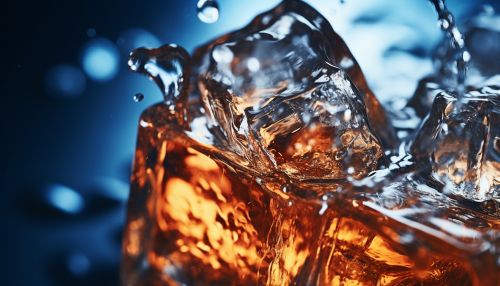Melting
Introduction
Melting, also known as fusion, is a physical process that results in the phase transition of a substance from a solid to a liquid. This process occurs when the internal energy of the solid increases, often by the application of heat or pressure, which increases the substance's temperature to the melting point. At the melting point, the ordering of ions or molecules in the solid breaks down to a less ordered state, and the solid melts to become a liquid.
Thermodynamics of Melting
The thermodynamics of melting is a complex process that involves the transfer of energy in the form of heat. The heat energy required to change a substance from a solid to a liquid, without changing its temperature, is known as the heat of fusion or enthalpy of fusion. This is a type of latent heat, as it is energy that causes a change of state without a change in temperature.
The heat of fusion is a function of the pressure at which that transformation takes place. The melting point of a substance depends on pressure and is usually specified at standard pressure. When considered as the temperature of the reverse change from liquid to solid, it is referred to as the freezing point or crystallization point.
Melting Point and Freezing Point
The melting point of a substance is the temperature at which it changes state from solid to liquid. The freezing point of a substance is the temperature at which it changes state from liquid to solid. For most substances, the melting point and freezing point are the same. However, certain substances possess differing solid-liquid transition temperatures. For example, agar melts at 85 degrees Celsius (185 degrees Fahrenheit) and solidifies from 31 degrees Celsius to 40 degrees Celsius (89.6 degrees Fahrenheit to 104 degrees Fahrenheit).
Supercooling and Superheating
Supercooling, also known as undercooling, is the process of lowering the temperature of a liquid or a gas below its freezing point without it becoming a solid. A liquid below its standard freezing point will crystallize in the presence of a seed crystal or nucleus around which a crystal structure can form. However, lacking any such nuclei, the liquid phase can be maintained all the way down to the temperature at which crystal homogeneous nucleation occurs.
Superheating is the phenomenon in which a liquid is heated to a temperature higher than its boiling point, without boiling. Superheating is achieved by heating a homogeneous substance in a clean container, free of nucleation sites, while taking care not to disturb the liquid.
Applications of Melting
Melting has a wide range of applications. In metallurgy, it is used to produce a wide range of alloys with specific properties. In glassmaking, raw materials are melted to produce a liquid that can be molded into shapes. In polymer processing, melting is essential to create a wide range of products from plastics and rubber. In food processing, melting is used in a range of processes, such as cooking, baking, and chocolate making.
See Also


